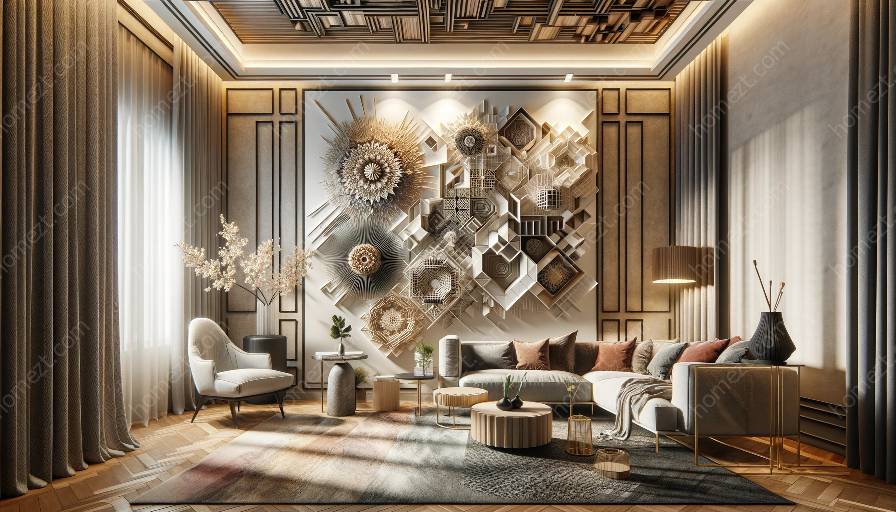Incorporating three-dimensional wall decor into interior design provides an opportunity to reflect and celebrate the rich tapestry of local cultural heritage. With its ability to bring depth, texture, and meaning to a space, three-dimensional wall decor stands as a powerful medium for communicating the unique stories and traditions of a community. In this guide, we'll explore how three-dimensional wall decor can be used to authentically showcase and honor local cultural heritage, providing practical tips and creative ideas for infusing meaningful elements into decorating with three-dimensional wall art.
Understanding Local Cultural Heritage
Before delving into the use of three-dimensional wall decor to celebrate and reflect cultural heritage, it's crucial to understand the essence and significance of local culture. Cultural heritage encompasses a wide range of tangible and intangible elements, including art, architecture, traditions, language, cuisine, folklore, and more. It embodies the collective experiences, identity, and values of a specific place or community, passed down through generations. By recognizing and honoring local cultural heritage, individuals and communities can foster a sense of belonging, pride, and continuity.
Exploring Three-Dimensional Wall Decor
Three-dimensional wall decor refers to artwork or decorative elements that extend beyond a two-dimensional plane, adding depth and visual interest to the walls. This can include sculptures, relief art, textured panels, and other artistic installations. The versatility and expressive potential of three-dimensional wall decor make it a compelling platform for portraying cultural heritage in a captivating and immersive way. By leveraging varied materials, forms, and techniques, three-dimensional wall decor can effectively evoke the essence of local traditions and narratives.
Integrating Local Cultural Elements
When aiming to reflect and celebrate local cultural heritage through three-dimensional wall decor, it's crucial to integrate authentic and meaningful elements that resonate with the community's identity. This can encompass a spectrum of considerations, such as historical motifs, indigenous craftsmanship, symbolic colors, traditional patterns, iconic symbols, and storytelling themes. By conscientiously selecting and incorporating these cultural elements into three-dimensional wall decor, designers and decorators can create environments that honor and embrace the spirit of the local heritage.
Examples of Cultural Integration
To illustrate the integration of local cultural elements into three-dimensional wall decor, let's consider a few examples:
- Traditional Craftsmanship: Commissioning skilled local artisans to create intricate relief sculptures or decorative panels that showcase traditional crafting techniques indigenous to the area.
- Heritage Motifs: Embracing the motifs and symbols that hold cultural significance, such as floral patterns, geometric designs, or animal representations specific to the local folklore and traditions.
- Narrative Installations: Crafting three-dimensional wall art that narrates stories, legends, or historical events relevant to the community, using sculptural elements and visual storytelling techniques.
Considering Spatial Context
When employing three-dimensional wall decor to reflect and celebrate local cultural heritage, it's essential to consider the spatial context within which the art will be displayed. Understanding the architectural environment, interior design style, and the flow of the space is crucial for ensuring that the three-dimensional wall decor harmonizes with its surroundings while effectively communicating cultural narratives.
Community Involvement and Collaboration
Engaging the local community in the process of creating and integrating three-dimensional wall decor can enrich the authenticity and relevance of the cultural expressions. Collaborating with community leaders, artists, historians, and residents can provide valuable insights and ensure that the representations are accurate, respectful, and meaningful to the community.
Utilizing Three-Dimensional Wall Decor for Cultural Education
Beyond its decorative function, three-dimensional wall decor can serve as a tool for cultural education and awareness. Incorporating explanatory plaques, interactive elements, or digital enhancements alongside the three-dimensional art can provide context and enrich the understanding of the local cultural heritage for visitors and residents alike.
Preserving and Evolving Traditions
By incorporating local cultural heritage into three-dimensional wall decor, individuals and communities actively contribute to the preservation and evolution of traditions. This practice showcases the enduring relevance and adaptability of cultural expressions, reinforcing their value within contemporary contexts and future generations.
Conclusion
Three-dimensional wall decor offers a compelling canvas for expressing and honoring local cultural heritage. Through deliberate integration of authentic elements, mindful context, and community involvement, three-dimensional wall decor can serve as a genuine reflection and celebration of the rich tapestry of local traditions and narratives, enriching the aesthetic and cultural fabric of the spaces it inhabits.






































